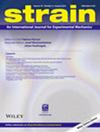对 42CrMoS4-QT 试样进行疲劳强度评估的格林卡和纽伯方法比较研究
IF 1.8
3区 材料科学
Q2 MATERIALS SCIENCE, CHARACTERIZATION & TESTING
引用次数: 0
摘要
在疲劳强度评估中,采用了巴斯金(Basquin)基于理想弹性应力的方法和曼森(Manson)、科芬(Coffin)和莫罗(Morrow)基于弹塑性应力量的较不成熟的方法。前者使用线性弹性应力计算载荷,后者则需要弹塑性评估参数,如应力和应变。这些参数可通过有限元分析(FEA)确定,并采用线性弹性结构定律,然后使用 Neuber 的宏观支撑公式转换为弹塑性载荷。在本文中,我们将 Glinka 提出的近似弹塑性参数的替代方法与使用 Neuber 公式的应变-寿命法以及 Basquin 的应力-寿命法进行了比较。对 42CrMoS4-QT 试样的几个组件测试进行了研究。为了确定疲劳强度评估的输入数据,整个试验装置都通过有限元分析进行了计算。这些经过验证的全模型模拟的节点位移被用作缺口子模型模拟的边界条件,其结果作为疲劳强度评估的输入。结果表明,所有方法都能对部件进行可靠的评估。我们的主要结果是,采用 Glinka 的概念进行缺口应力计算的应变-寿命法在疲劳强度评估中取得了更好的结果。本文章由计算机程序翻译,如有差异,请以英文原文为准。
A comparative study of Glinka and Neuber approaches for fatigue strength assessment on 42CrMoS4‐QT specimens
In fatigue strength assessment, the methods based on ideal elastic stresses according to Basquin and the less established method based on elastic‐plastic stress quantities according to Manson, Coffin and Morrow are applied. The former calculates loads using linear‐elastic stresses, the latter requires elastic‐plastic evaluation parameters, such as stresses and strains. These can be determined by finite element analysis (FEA) with a linear‐elastic constitutive law, and subsequent conversion to elastic‐plastic loads, using the macro support formula by Neuber. In this contribution, an alternative approach to approximate elastic‐plastic parameters proposed by Glinka is compared to the the strain‐life method using Neuber's formula, as well as the stress‐life method of Basquin. Several component tests on 42CrMoS4‐QT specimens are investigated. To determine the input data for the fatigue strength evaluations, the entire test setup is computed by FEA. The nodal displacements from these validated full‐model simulations are used as boundary conditions for a submodel simulation of a notch, whose results serve as input for the fatigue strength assessments. It is shown that all approaches provide a reliable assessment of components. Our key result is that the strain‐life method using the concept by Glinka for notch stress computation, yields improved results in fatigue strength assessments.
求助全文
通过发布文献求助,成功后即可免费获取论文全文。
去求助
来源期刊

Strain
工程技术-材料科学:表征与测试
CiteScore
4.10
自引率
4.80%
发文量
27
期刊介绍:
Strain is an international journal that contains contributions from leading-edge research on the measurement of the mechanical behaviour of structures and systems. Strain only accepts contributions with sufficient novelty in the design, implementation, and/or validation of experimental methodologies to characterize materials, structures, and systems; i.e. contributions that are limited to the application of established methodologies are outside of the scope of the journal. The journal includes papers from all engineering disciplines that deal with material behaviour and degradation under load, structural design and measurement techniques. Although the thrust of the journal is experimental, numerical simulations and validation are included in the coverage.
Strain welcomes papers that deal with novel work in the following areas:
experimental techniques
non-destructive evaluation techniques
numerical analysis, simulation and validation
residual stress measurement techniques
design of composite structures and components
impact behaviour of materials and structures
signal and image processing
transducer and sensor design
structural health monitoring
biomechanics
extreme environment
micro- and nano-scale testing method.
 求助内容:
求助内容: 应助结果提醒方式:
应助结果提醒方式:


